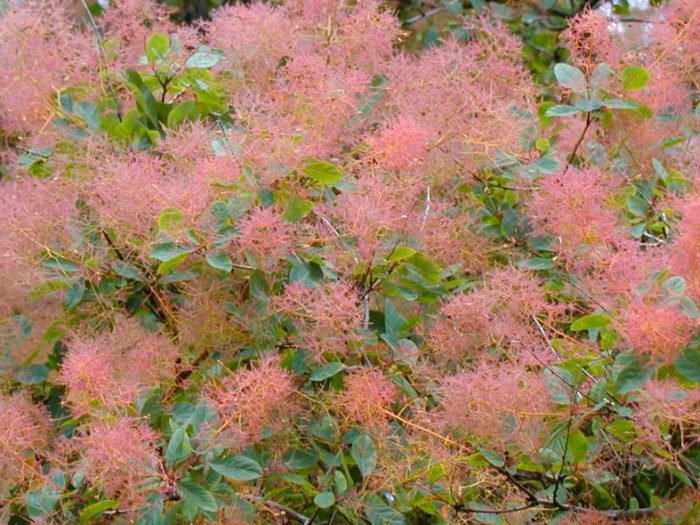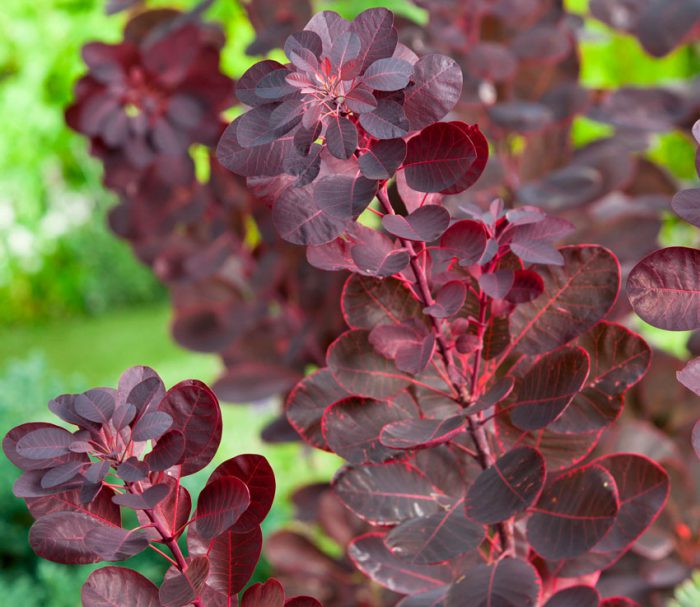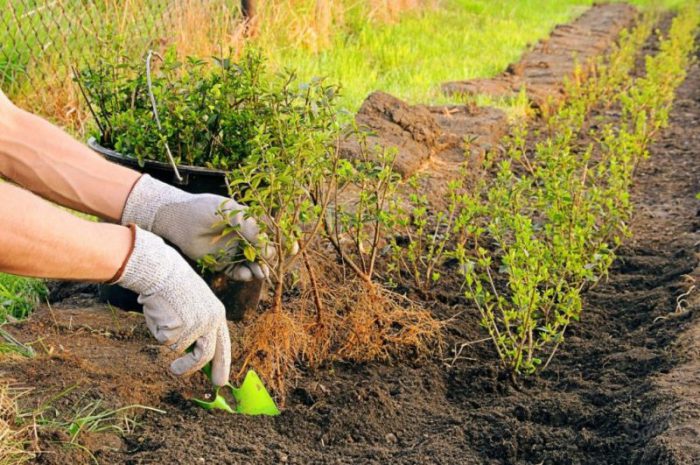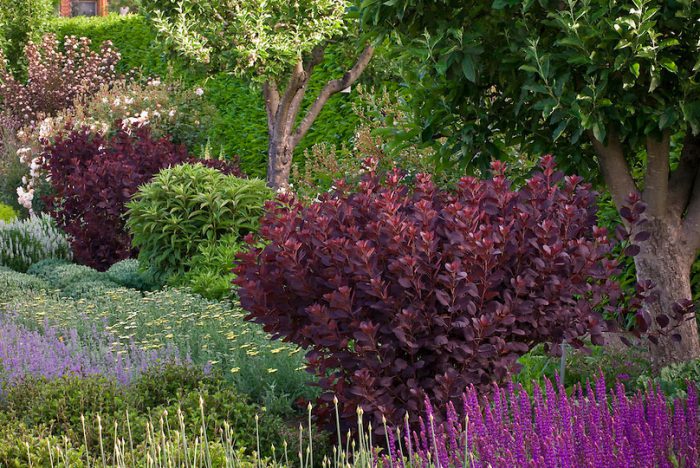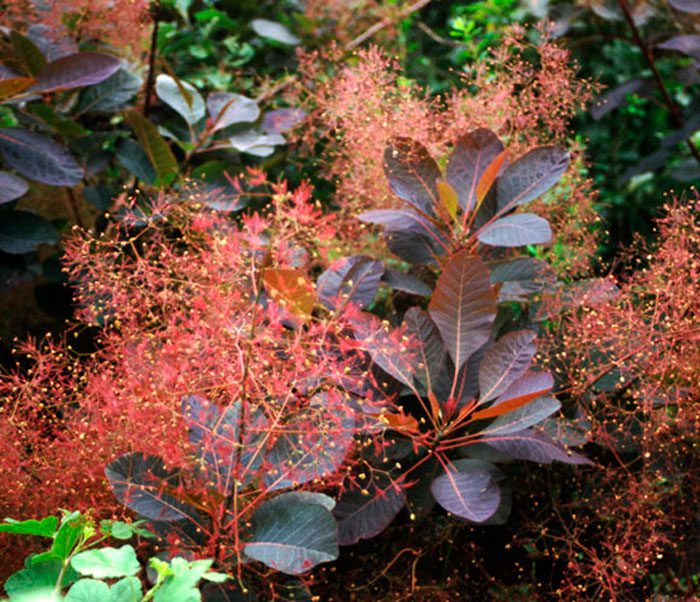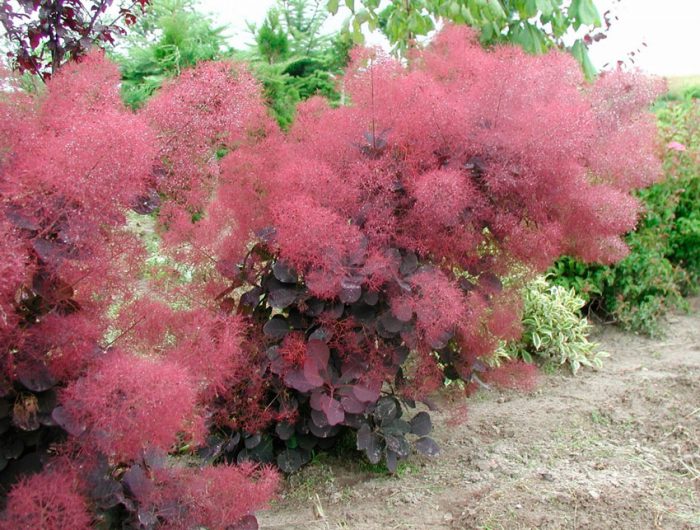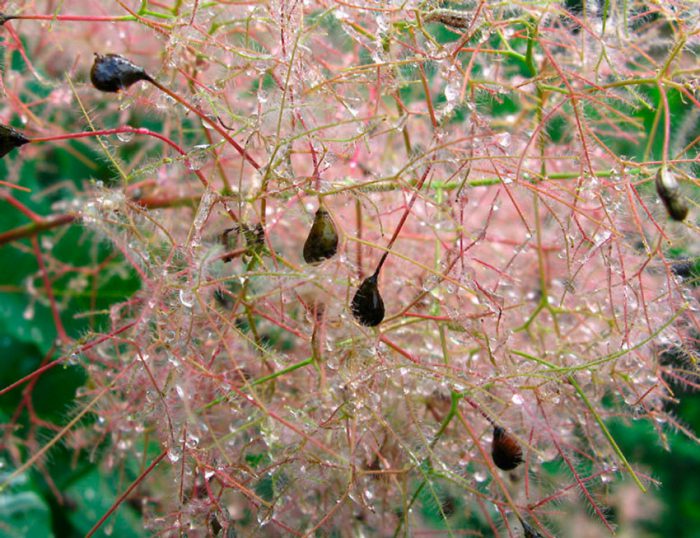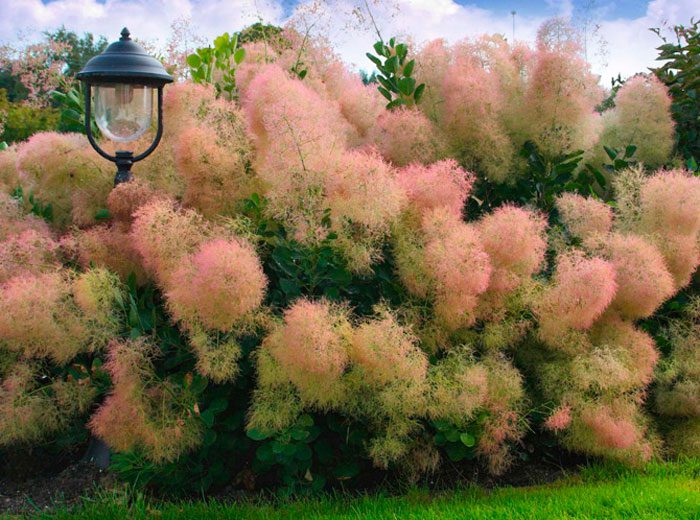The deciduous shrub or scumpia tree (Cotinus) is a member of the sumac family. In nature, such a plant can be found in areas with a temperate climate in Eurasia and in the eastern part of North America. This genus unites only 2 species. The Frenchman J. Tournefort, who was a botanist and doctor, called this plant "cotinus", in ancient Greece this was the name of the wild olive. Such a tree grew on Earth already in the days of the ancient world, perhaps this can explain the fact that it has quite a lot of names, for example: Venetian sumac, wig bush, yellowberry, tanning tree, smoky tree, etc. Today such a plant is grown in on an industrial scale, it is used as a source of fizegin (orange and yellow dye for wool, leather and silk). The greenish-yellow wood of the scumpia is used for making crafts, and the foliage is used for tanning leather. Also, this plant is grown as a decorative leafy plant, decorating your garden with it.
Content
Features of the scumpia
Tanning scumpia, or ordinary scumpia, is a branched shrub that reaches a height of 150–300 centimeters or a tree five meters in height with a compact wide-oval umbrella-shaped crown. The peeling bark is colored brown. Bare light red or green stems, when broken, secrete milky juice. Simple alternate leathery petiolate leaf plates of obovate shape can be entire or slightly toothed. They are painted in dark red or green, which takes on a purple tint in autumn. Small pale green flowers are part of the dense paniculate inflorescences, reaching 0.3 m in length.The flowering of the scumpia begins in May or June, at this time the peduncles are lengthened, and a light red long pile appears on their surface, thanks to this one might think that the plant is covered with a pale red mist. The fruit is a small green drupe with a long stalk. The ripe fruit turns black. Scumpia can live for about 100 years.
Planting a scump in open ground
What time to plant
If you purchased seedlings with a closed root system, then you can start planting them at any time of the year, of course, except for the winter period. However, there are a couple of nuances to consider. Skumpia has a rather long growing season in this regard, if it is planted very late in autumn, then it simply will not have time to adapt normally and prepare for wintering. If this procedure is carried out in late spring, then the rooting of the seedling in a new place will also be difficult due to excessive heat. The site for such a plant should be spacious, sunny and protected from gusts of wind, but it can also be grown in a little shade. The most suitable is a permeable, light, alkaline or neutral soil, but scumpia can be grown in heavy or acidic soil, as well as on rocks. However, when choosing a site for planting, it should be borne in mind that lowlands or places with a close occurrence of groundwater will not work, since such a plant reacts extremely negatively to stagnant fluid in the root system.
Landing features
Seedlings should be removed from the container 24 hours before planting and their root system should be placed in water. Before planting, the root system is carefully examined, while it will be necessary to cut off dried or diseased roots, then you need to treat the sections with a fungicide, and then sprinkle them with chopped charcoal. The size of the planting hole should be slightly larger than the volume of the seedling root system. It is not necessary to add fertilizers to the soil or use a special soil mixture, since the scumpia will take root much faster in poor soil. To begin with, pour 20 liters of water into the hole and wait until it is completely absorbed. Then a little earth is poured into it so that a mound is formed on which the seedling is installed. When the roots are carefully spread out, the hole must be filled with earth, which is carefully compacted. The planted skumpia needs to be watered very well. In a newly planted seedling, the root collar should rise 20-30 mm above the soil surface, when the plant is watered, it will be flush with the ground.
Skumpia care
It is relatively easy to plant and grow such a plant. Newly planted bushes need frequent and abundant watering until they are completely rooted. Watering of adult bushes is carried out only when there is a need for it, while it should be rare, but abundant. Remember that scumpia does not tolerate stagnant liquid in the root system. In spring, when the soil warms up well, it is recommended to cover the trunk circle with a layer of mulch, this will significantly reduce the amount of watering. If the soil is poor on the site, then the plant will need to be fed. When the growing season just begins, the skumpia will need nitrogen-containing fertilizers; from the second half of the summer period, it will be necessary to use phosphorus-potassium fertilizers for feeding. This plant responds well to both mineral and organic fertilizers. In the event that the soil at the site is saturated with nutrients, most likely you will not have to feed the skumpia.
Pruning
For the normal development of the scumpia, it will need infrequent but systematic pruning. They are carried out with a frequency of 1 time in 2 or 3 years around May, it is necessary to have time before the kidneys open. During this procedure, it is necessary to cut off the branches injured and damaged by frost, and it is also necessary to make a formative pruning at the same time. In young bushes, annual stems are shortened by 2/3, while old shoots, if desired, can be cut into a stump. With systematic and correct formative pruning, the plant will be lush, while the foliage will be large and rich in color.
Bloom
The blooming scumpia is simply a stunning sight.This plant looks airy and very delicate. If it is grown in warm areas of the middle lane, then during one season it will bloom several times. Feathery panicle inflorescences consist of cream or pale yellow flowers. The first flowering is observed in May, and the next - in the second half of the summer period.
Diseases and pests
This plant is highly resistant to diseases and pests. However, in very rare cases, a small pistachio bark beetle, a fawn leaf beetle, and a scumpian beetle can settle on it. To destroy these pests, the affected bush must be treated with Decis or Karbofos.
Shelter for the winter
Young bushes need a mandatory shelter for the winter. However, first of all, you need to cover the trunk circle with a thick layer of mulch (humus or peat) and this must be done regardless of whether your old scumpia is growing or young. Next, you need to strap young bushes with spruce branches, but experts recommend covering them with completely non-woven material. Adult plants that are adapted for cultivation in the middle lane do not need shelter for the winter
Scumpia care in the Moscow region
If you grow scumpia in the suburbs, then you should take a responsible approach to choosing the type and variety of plants, and you also need to pay special attention to the plant when preparing it for wintering. For the cultivation of scumpia in the Moscow region and Moscow, it is recommended:
- choose the type and variety that is highly winter hardy;
- purchase those seedlings in nurseries that have survived one or two winters;
- choose a landing site, protected from wind gusts and drafts;
- cover young bushes for the first few winters.
Varieties and species with green foliage are distinguished by the highest frost resistance. The same varieties that have purple foliage can suffer from severe frosts in winter with little snow, while the bush freezes to the level of snow cover. However, during the growing season, the plant is able to fully recover, but it will no longer bloom this year.
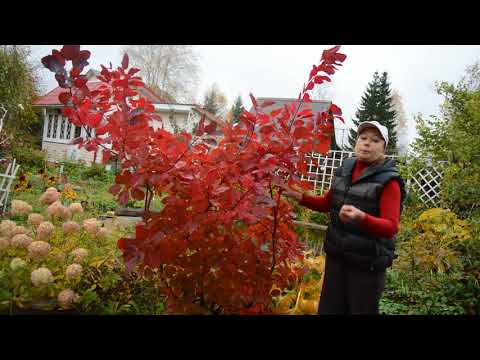

Watch this video on YouTube
Reproduction of scumpia
Scumpia can be propagated by seed (generative) method, as well as vegetative - by layering, cuttings and shoots.
How to grow from seeds
Scumpia is grown from seeds most often by professionals. Fruit ripening occurs at the end of the summer period, after which seeds are taken out of them. For spring sowing, the seeds must be prepared, they need three or four months of stratification, for this they are placed in a place with an air temperature of 3 to 5 degrees. The seeds are covered with a very strong shell that does not allow water to pass through, and it is very difficult for a sprout to break through it. In this regard, before sending seeds for stratification, they must be scarified. To do this, the seeds must be immersed in sulfuric acid for a third of an hour, which will make the coating loose and dissolve it. In the event that the seeds are sown before winter immediately after harvesting, then they should not be stratified. The fact is that in winter they will undergo natural stratification. Sowing seeds in open soil is carried out in spring or autumn, while they need to be buried only 20 mm. Crops for the winter do not need to be covered. The first seedlings will appear 12 months after sowing.
Cuttings
The harvesting of green cuttings is carried out in June, then they are immersed in a Heteroauxin solution overnight. Planting should be done in the morning, while a greenhouse should be made above the container with cuttings. The composition of a substrate suitable for rooting includes sand, peat and turf soil (1: 1: 1). Remember to regularly air the cuttings, and provide them with moderate but frequent watering (it is recommended to spray them with a sprayer). The roots of the cuttings should appear after 20 days, but it should be borne in mind that, according to statistics, only 3 cuttings out of 10 take root.
Reproduction by layering
In springtime, choose the stem that grows close to the ground. Then a longitudinal incision is made on its outer surface, not high from the base. This stem must be bent to the surface of the ground and fixed in this position. Then you need to cover it with earth in the part where there is an incision. Throughout the growing season, do not forget to water the cuttings in a timely manner, separate it from the parent bush after complete rooting, and then transplant it to a permanent place.
Types and varieties of scumpia with photos and names
In this genus, there are only 2 species, namely: American scumpia and common scumpia.
Skumpia ordinary, or leather skumpia (Cotinus coggygria)
In nature, this type of scumpia can be found on the southern mountain slopes of the Himalayas, in the Crimea, in Western Asia, in China, in the Mediterranean and in the Caucasus. The height of such a branchy shrub can vary from 150 to 300 centimeters. In some cases, this species is represented by trees, the height of which can reach up to 5 meters, they are covered with peeling bark, painted brown, bare stems can be light red or green, there are also alternate, usually whole-edged, but sometimes weakly serrated leaf plates obovate or ovoid, their length is about 7 centimeters. Relatively large, but rare panicle inflorescences reach 0.3 m in length, they consist of many bisexual flowers of light green or pale yellow color. The fruit is a small dry drupe. This species has a large number of forms, the most popular of them are: red-leaved, weeping and creeping scumpia. Forms with green leaves have a relatively high winter hardiness compared to red-leaved ones. This must be remembered for those gardeners who want to cultivate scumpia in the Moscow region. But not all red-leaved varieties have low frost resistance. Most popular varieties:
- Lady Young... The height of such a plant can be up to 400 centimeters. The color of the foliage is green, the inflorescences consist of flowers, which eventually change their green color to cream, and cream, in turn, to pink. The life span of a given plant can vary from 40 to 60 years.
- Grace... This shrub is vigorous and can reach a height of 500 centimeters. Large oval-shaped soft leaf plates reach 5 centimeters in length, they are painted in red-purple color, which changes to scarlet in autumn. Large conical inflorescences reach 20 centimeters long, they consist of flowers of purple-pink color.
- Scumpia purpurea (Purpurea)... Plant height is about 7-8 meters. Its flower panicles and leaf plates are purple and pubescent.
- Golden Spirit... Yellow leaf plates along the edge and along the veins have an orange tint. When grown in partial shade, the leaves turn greenish-yellow. In autumn, the leaves begin to gradually become covered with an orange-red blush. In autumn, this variety looks incredibly impressive due to the fact that its foliage is painted in various "autumn" colors: from dark purple to pale yellow and pale green.
- Royal Purple... This variety is slow growing. Its height can be up to 150 centimeters. The spreading crown has a rounded shape. Large leaf plates are brownish-red in summer, and pale blue metallic in autumn. The red flowers have a silvery sheen. The life span of the plant is about 70 years.
American scump (Cotinus americanus), or obovate (Cotinus obovatus), or olive sumach (Rhus cotinoiides)
This is not a very large tree in mid-latitudes in height reaches no more than 500 centimeters.The rich green leaf plates are about 12 centimeters long, which is almost 2 times the size of the leaves of the common scumpia. But the length of the inflorescences of this species does not exceed 15 centimeters, they are colored red-brown-green. The homeland of this species is the Southeast of the United States of America (Texas, Tennessee and Alabama). In these places, this tree is called the American smoketree, which translates as "American smoking tree." This type is not used in the leather industry, and this plant does not contain yellow pigment, but it has a decorative appearance. Large green foliage in autumn changes its color to fiery red, and the bush becomes like a blazing fire. In European countries, at the moment, this type of skumpia is not very much in demand, despite the fact that it has a high frost resistance. He can suffer in winter only from a very severe frost. You should also know that this is an unpretentious plant that does not impose special requirements on growing conditions.


Watch this video on YouTube

